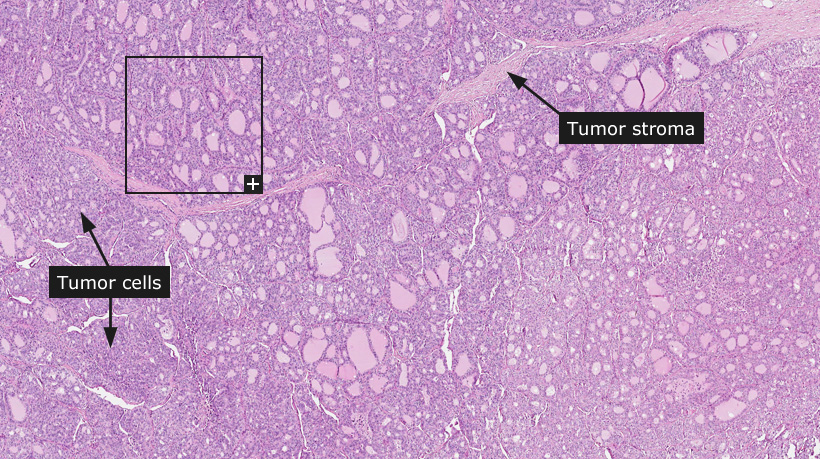Thyroid cancer
Male, 75 years, follicular thyroid carcinoma 
Thyroid cancer
Thyroid cancer is fairly common, with an annual incidence ranging from 0.5 to 10 per 100,000 in various populations. Throid cancer is two to four times as frequent in women as in men. The most common form of thyroid cancer is papillary carcinoma (70-80%), followed by follicular carcinoma (10-20%), medullary carcinoma (5-10%) and anaplastic carcinoma (2-10%). Classification according to WHO subdivides thyroid tumors into several different subtypes dependent on histological features. Thyroid tumors can also be classified according to aggressiveness into low-grade malignant, intermediate-grade malignant and high-grade malignant.
The prognosis is good for the major forms of thyroid cancer, with a 10-year relative survival rate of 98% for papillary carcinoma, 92% for follicular carcinoma, and 80% for medullary carcinoma. Besides age, where young patients have a considerably better prognosis, the size of the primary tumor and the tumor stage are the most significant prognostic factors.
Papillary thyroid carcinoma is defined as a malignant epithelial tumor. Microscopically the tumor shows evidence of follicular cell differentiation, typically with papillary and follicular structures as well as characteristic changes in tumor cell nuclei. The key to an accurate diagnosis are nuclear characteristics, including a ground glass appearance, large size, pale staining and irregular outline with deep grooves and pseudoinclusions. Papillary thyroid carcinoma is an indolent cancer, with an excellent long-term prognosis, despite a propensity to invade locally and to spread metastatically to regional lymph nodes. Distant metastases are uncommon.
Follicular carcinoma shows follicular differentiation but lacks the diagnostic features of papillary carcinoma. The incidence of follicular carcinoma is higher in areas of endemic goiter and iodine deficiency appears to be the main contributing risk factor. In contrast to papillary carcinoma, the main mode of metastatic spread is hematogeneous rather than through the lymphatic system. Follicular carcinoma is typically delimited by a fibrous capsule surrounding tightly packed follicles, trabeculae or solid sheets of tumor cells. Tumor cells are often cuboidal with dark or pale staining nuclei with inconspicuous nucleoli. Occasional follicular carcinomas may exhibit nuclear pleomorphism.
For most thyroid tumors, diagnosis can be established by microscopic examination alone, although immunohistochemistry plays an important role in tumors exhibiting unusual morphological features. Antibodies used in diagnostics of thyroid tumors include thyroglobulin (TG), calcitonin (CALCA) and thyroid transcription factor (TTF1).
Normal tissue: Thyroid gland
|